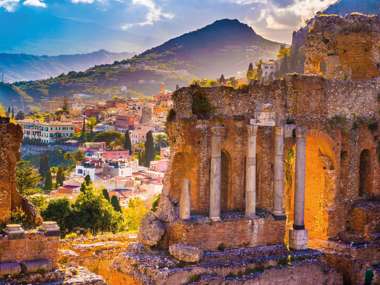A personal account from Treasures of Sicily
Jules Verne’s first post-lockdown tour to Sicily commenced on the 22nd September. After slowly coming to terms that it may be Spring 2021 until I would next board a plane into the sunshine, I was introduced to the idea of joining the group to ensure everything operated as carefully planned. Although I was slightly apprehensive, the idea of seeing Sicily quickly swayed any ‘what-if’s’.
Within a few days, my case was packed and at 4:00 am I arrived at Gatwick airport and boarded the partially empty shuttle bus to the terminal. Upon arrival, I was greeted with a stand of antibacterial gels and it was evident that our safety was the top priority. The airport itself had a good atmosphere; the main change was no quick spritz of perfume in duty-free! Passengers mostly seemed to respect others’ social distancing needs and the food outlets such as Pret a Manger and Starbucks did not have a queue. Passengers enjoyed their morning tea/ coffee and a welcome chance to remove their mask for a short period.
We were fortunate with a rather empty flight from London Gatwick to Catania. Food and drink were served on board, however, this is currently not guaranteed so I would recommend purchasing some in the airport before take-off. Once we landed in Catania our bags were waiting to be collected, a seamless exit and we boarded our spacious buses to Catania.
During our welcome meeting, our guide Beatte confirmed Sicily has slightly different guidelines to the UK; masks were to be worn inside buildings including hotels, private vehicles and outside if you are in a ‘group of people’. Sicily also has their own version of ‘Track and Trace’ called SicilliaSiCura which is specifically for tourists. We were provided radio audio devices called whispers these allowed us to hear Beatte in our headphones. This was a great advantage as although the sites were quiet it meant we could socially distance and still clearly hear the information provided.
Catania is a quirky town filled with tall residential houses and hotels sporting Juliette balconies. I couldn’t help but reflect on the videos on social media of Italians singing on their balconies during their strict lockdown as we ventured out to explore. Once we had decided where the best people-watching bar would be for our aperitif later that afternoon we joined our 26 seat coach which would be our main transport for the journey.
Next, we travelled approximately an hour south towards Ancient Syracuse. Transported back in time we wandered through the Ortigia district, 2400 years ago it was the most important and impressive Greek city. Today baroque architecture dominates its narrow streets and the Piazzo del Duomo stands proudly in the centre. The Syracuse Cathedral displays columns from the original Greek Doric temple of the 5th century BC as the Cathedral was built in the 7th century on its remains.
We travelled further back in time when we visited the UNESCO site of Syracruse which displays Teatro Greco, an amphitheatre thought to welcome 16,000 people. The impressive theatre was built in the 5th century BC and re-built in the 3rd century.
Leaving Catania behind, we travelled inland to Piazza Armerina which is home to UNESCO site Roman Villa del Casale. Mosaics cover almost every room with each room being decorated with its own scene. The luxury villa boasts one of the richest, largest and most varied collections of Roman mosaics in the world. The one-way system around the Villa is welcomed and allowed the group to spaciously view the mosaics such as the ‘Bikini Girls’ below:
Continuing with the theme of visiting UNESCO sites, we travelled towards the coast to Agrigento and the “Valley of the Temples”. We were extremely fortunate to visit most of the temples alone. The extensive archaeological site contains seven Greek Doric temples dating back to the 5th and 6th century BC. On visiting the Temple of Hercules eight columns remain standing whilst the broken columns scatter the floor below. The Temple of Concordia was my favourite temple and is one of the best-preserved Doric temples in the world. With the sun shining we quickly removed our masks for a group photo.
Following the coast towards Western Sicily, we visited seaside Selinunte. The Greek archaeological site is situated on the Sicilian sandy beachfront. With the sound and smell of the ocean, we explored the ancient town of Selinus. Typically when one visits ancient sites you are unable to enter, however, in Selinunte we were extremely fortunate to explore the Doric temple (Temple E) from the inside. This site was probably the busiest, with under 10 other visitors exploring during the time we spent there. Leaving Selinunte behind we travelled north-west to Marsala to sample the delights of Sicilian Marsala wine.
Arriving in Palermo our focus shifted towards the magnificent churches and chapels. The La Martorana is a jaw-droppingly beautiful 12th-century church which was originally planned to be a mosque. The multiplicity of styles includes the remaining Byzantine mosaics but mostly consists of a baroque interior. Palermo felt busier than the other towns we had visited, however, it felt nice to be in a more populated town and embrace the busier atmosphere. Byzantine mosaics also decorated the Palatine Chapel as well as Monreale’s Cathedral. The dramatic cathedral has more than 6,000 square meters of mosaics, the Cathedral combines Norman, Byzantine and Islamic art.
Travelling east to Taormina we visited a small medieval coastal town, Cefalu. As cruising is currently limited, the town was much quieter. We enjoyed a peaceful stroll through the streets towards the Norman Cathedral. Seafront restaurants slowly filled, so that diners could watch the dramatic sea. We then continued our journey towards Taormina. We disembarked the coach to view the Straits of Messina in the distance with the South of Italy only two miles away. Taormina is a glorious hilltop seaside town with not only narrow picturesque streets, but it is also home to an impressive Greco-Roman theatre which is still used today.
Our final day took us to Mount Etna, we were fortunate to have had rain the night before as the guides explained therefore the view of Etna was exceptionally clear. The options to view Mount Etna are to either take a cable car to 2,900 metres with a cost of 30 Euro or should you wish to travel towards the summit you will require the cable car and a 4x4 drive with a total cost of 66 Euro. At the end of the cable car, you have the option to rent a jacket for 5 Euro, but I would recommend taking a warm coat, gloves, scarf and a hat with you as it can be chilly. On the day we visited it was extremely windy and it was -4°. Braving the wind chill we ventured out to view Etna from the pathway. There were many tourists in Etna compared to our experiences during the rest of the tour, however upon investigating this was still extremely quiet compared to pre-COVID times.
On our last evening, the group enjoyed a traditional aperitif with appetisers in the main square in Taormina. A gentleman softly playing his guitar set the scene as we soaked in the last of the Sicilian sunshine overlooking the sea.
Our group of 14 passengers really enjoyed their tour to Sicily and some have mentioned they are planning to return on our Secret Sicily tour. Everyone seemed relieved to be travelling after such a long time, and with many trips cancelled it felt very rewarding to be able to travel again. I personally found taking a few precautions such as wearing masks, having your temperature taken on entry into sights and no musical chairs on the coach was a small sacrifice for quieter sites and the possibility of travel. Travel may look a little different for a while, but we look forward to welcoming you an adventure with Jules Verne whenever you are ready.




